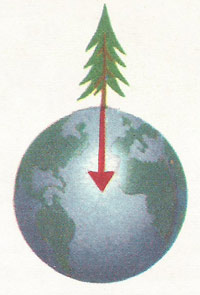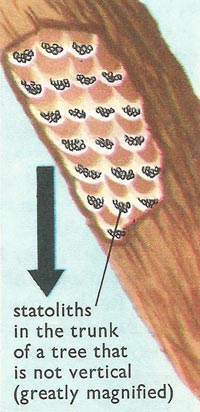geotropism

If we look at a pine tree growing on the side of a hill, we see that it does not grow at right angles to the earth, but always vertically upwards.

Geotropism (from the Greek ge, earth, and trope, turning) is the response of plant growth to the stimulus of gravity. Plant stems are generally negative geotropic and grow upward; Roots are positively geotropic and grow downward. For example, growth curvature is caused by the accumulation of the plant hormone auxin in the tissue on the lower side of the stem; growth increases on that side and the stem bends upward.
 |
Similarly, if a potted plant is laid on its side, the stalk will gradually curve upwards until its position is vertical. Some plants start reacting in this way within two minutes! All plants, from the moment of their germination arrange themselves with their roots pointing downwards and their stalks pointing upwards: this shows that they are capable of perceiving Earth's gravity and of reacting by disposing themselves in accordance with it. How does this happen?
The sap in some of the cells in a tree-trunk contains innumerable little beads in the bottom of a bag. These grains, called 'statoliths' (from the Greek statos, position, and lithis, stone), stimulate the activity of the auxin in the lower part of the cells so that the cells are elongated on the side facing the center of the earth, and this causes the plant to assume a vertical position. It is interesting to note that some animals, such as crabs, have organs which work like statoliths too.
 |


